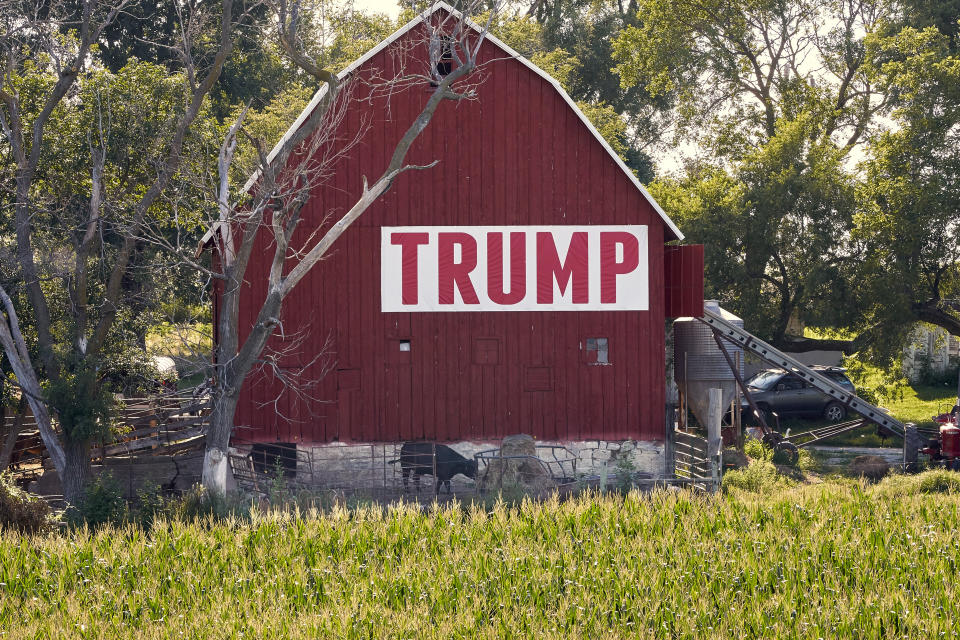'Is this sustainable?’: Farmers say bailouts aren’t enough in Trump’s trade war
The U.S. Department of Agriculture (USDA) announced on Thursday that it would provide an additional $16 billion to help farmers as the trade war between the U.S. and China carries on and tariffs stay in place.
Tyler Stafslien, a North-Dakota based farmer, described the impending aid package as “certainly needed,” but questioned how long this could go on.
“I would prefer we had the trade we used to have with China,” he told Yahoo Finance. “I don’t want to have to rely on the federal government to be able to survive out here as a farmer. My fear is there will be another payment here, but is this sustainable? At what point will the federal government stop paying farmers? Will we have the trade deal in place at that point to pick up where the federal government leaves off? I don’t know.”

Iowa Soybean Association President Lindsay Greiner, a soybean farmer, released a statement on behalf of his organization, expressing similar concerns.
“Short-term, stair-stepped subsidies are a poor remedy for trade,” he said. “They stimulate production but not sales and therefore do little to undo the long-term log jam caused by not selling soybeans to destinations like China, the world’s no. 1 customer.”
“Farmers have been reassured time and time again over the past year that results will be achieved, and agreements made with key trading partners. Yet it’s been all talk, and no action. It’s well past time for Congress and the Administration to put aside partisan differences, break the policy gridlock and get to work on issues that truly matter for the American people.”
This isn’t the first time that the government has stepped in to help farmers while the country engages in a trade war with China. In 2018, the Trump administration authorized a bailout program, which entailed two rounds of payments doled out to farmers to offset the effects of tariffs. By February 2019, it had reached $7.7 billion in aid.
After the most recent announcement, Missouri Farm Bureau President Blake Hurst said in a statement: “The program, following a spring of historic flooding, delayed planting and depressed prices, will give many farmers the opportunity to farm another year. Although every farmer would rather receive income through a well-functioning market than through government subsidies, the payment will make a positive difference for Missouri agriculture.”
During the previous round of payments, Hurst told Yahoo Finance that while the aid was appreciated, “it’s not enough in the sense that it no way makes us whole for what we suffered from these trade disputes.”
The lost business with China has had a major impact on U.S. agriculture. As a result of reduced exports to China in 2018, the U.S. saw the smallest agricultural trade surplus ($10.9 billion) since 2006. According to the USDA, exports were valued at $140 billion, only a 1% increase from 2017.

“There’s a lot of pain in farm country right now that’s directly related to the trade we’ve lost,” Stafslien said. “Farmers are barely getting by.”
He noted the fact that on top of retaliatory tariffs from the Chinese, weather also hasn’t been welcome to the plight of farmers in the Midwest. Flooding has hit the region relatively hard in the last few months, particularly in March 2019. Kelly Brunkhorst of the Nebraska Corn Board told NPR that she was estimating about $440 million in crop damages from the rain due to “unplanted crops, late planting,” and other effects.
“There isn’t a farmer I know that isn’t nervous, wondering if they’re going to survive this year,” Stafslien said. “The amount of capital we have to put into the ground every year, hoping to get a turn, is unsustainable with the prices that we currently have. They’re obviously directly affected by these tariffs and then you add a natural disaster on top of it, and I don’t know what rural America will look like in the end if this keeps up.”
Stafslien grows a number of crops, including spring wheat, soybeans, and lentils. Soybeans particularly have been affected by the trade war, as the Chinese have been the biggest customers of U.S. soybeans in the past.
But, in December 2018, the U.S. soybean inventory was projected to reach an estimated 955 million bushels in 2019, nearly doubling the 2018 stockpile. That projected number decreased to 910 million bushels in February 2019.
‘They’re providing lip service’
“President Trump has great affection for America’s farmers and ranchers, and he knows they are bearing the brunt of these trade disputes,” USDA Secretary Sonny Perdue said in a statement. “In fact, I’ve never known of a president that has been more concerned or interested in farmer wellbeing and long-term profitability than President Trump.”
However, Stafslien voiced his skepticism.
“The Trump administration realizes that it was the middle of America that elected them, and I think they’re providing lip service so that people don’t become politically unrestful out here,” he said. “I think it’s a way to appease the center of the country for a while so that there aren’t political ramifications.”

Trump has claimed that the Chinese are paying tariffs that are going directly to the Treasury, and in turn, helping farmers. That is inaccurate, though, as these tariffs are actually being paid by American businesses and passed on to consumers.
And, Stafslien added, the tariffs have affected “all of our crops.” Although he grows soybeans, the crop that has been hit the hardest, he has seen an impact all over.
“It’s not like you take one commodity and hurt it with tariffs and it doesn’t affect the other,” he said. “It’s a cascading, tidal wave effect with everything.”
Adriana is an associate editor for Yahoo Finance. Follow her on Twitter @adrianambells.
Read the latest financial and business news from Yahoo Finance
READ MORE:
Follow Yahoo Finance on Twitter, Facebook, Instagram, Flipboard, SmartNews, LinkedIn, YouTube, and reddit.


